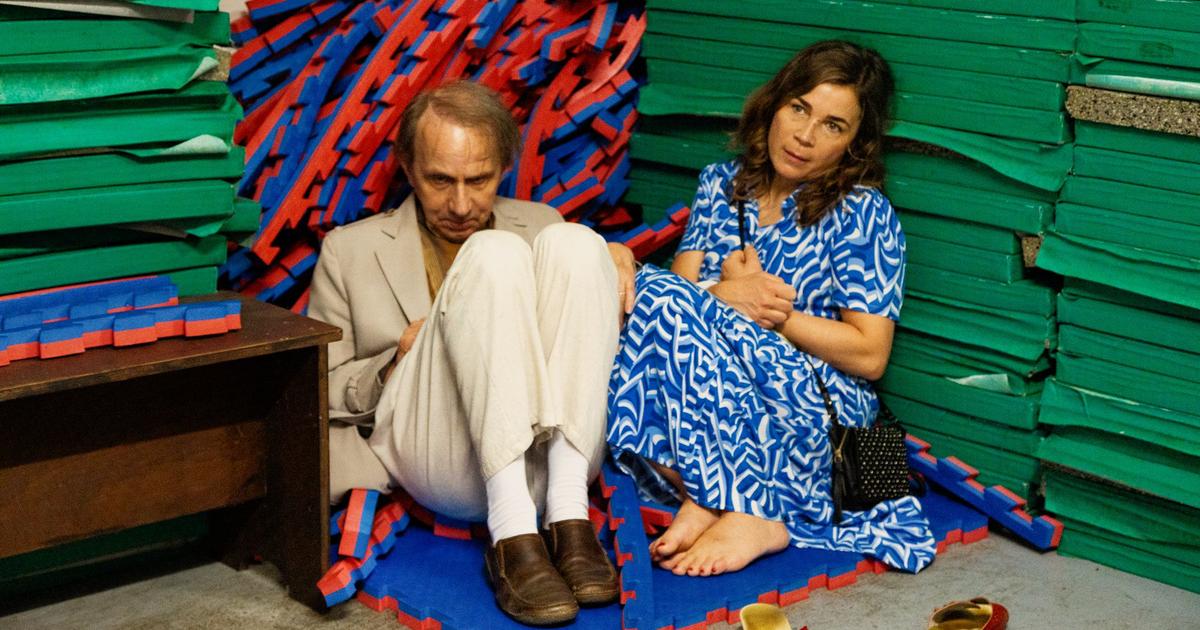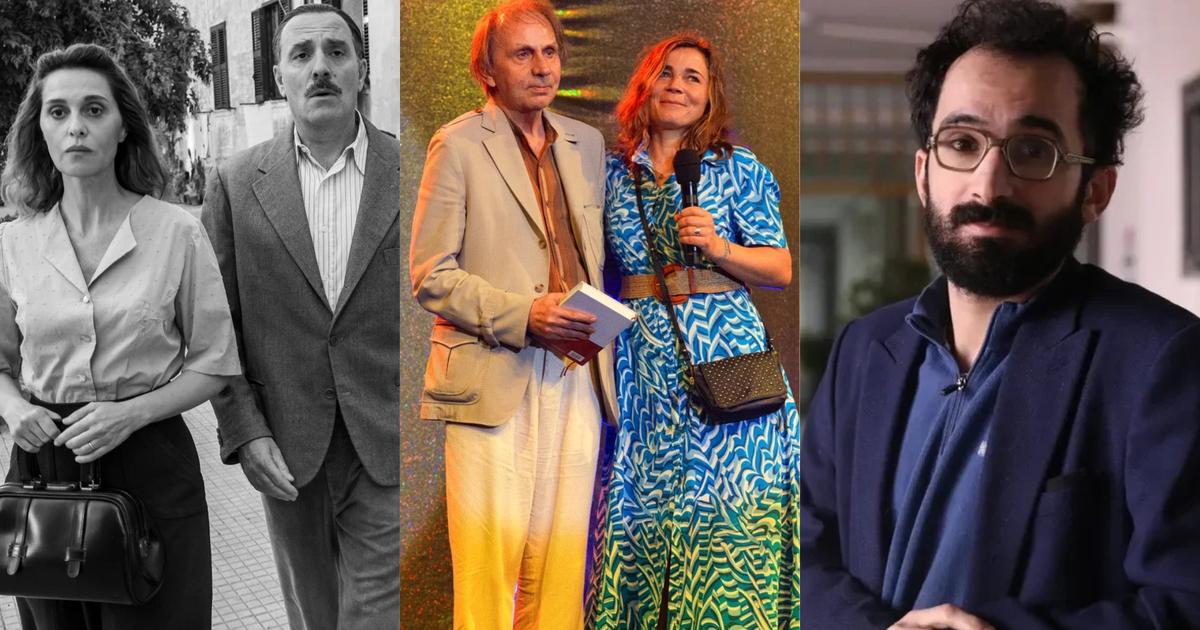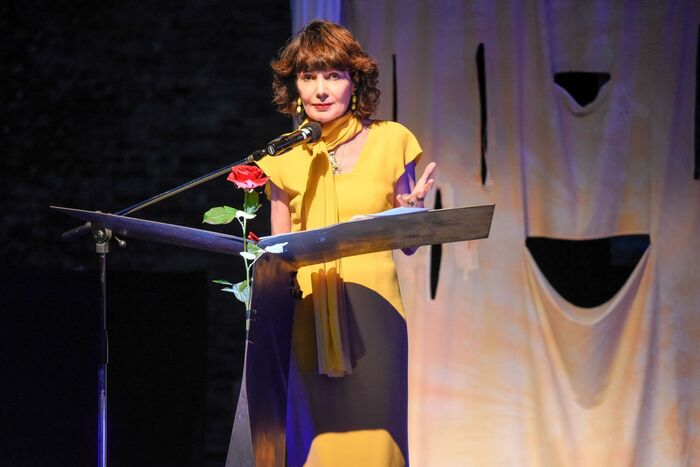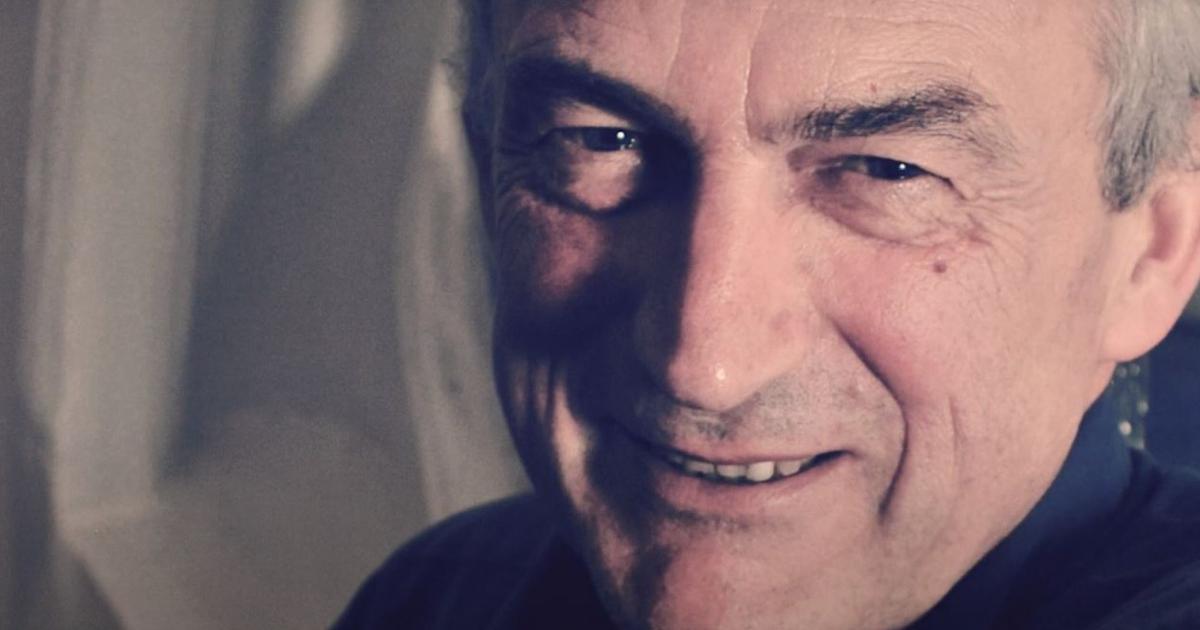AMSTERDAM – On Saturday night, an eclectic group of artists gathered outside an industrial garage in Amsterdam East, where Michel Houellebecq, a celebrated French writer, was scheduled to give a speech.
Houellebecq had published on May 24 "Some Months of My Life," a new book describing a tumultuous period from October to March in which he collaborated with a Dutch art collective called KIRAC.
Together they worked on a film, shooting scenes showing the 67-year-old married author kissing young women.
The art collective was embroiled in court battles over a film about the sex life of celebrated French writer Michel Houellebecq. (KIRAC via The New York Times) -
Although Houellebecq had consented to shoot the film, he later changed his mind and tried to back down.
Starting in February, it filed lawsuits in France and the Netherlands to prevent the film from being shown.
Last month, an Amsterdam judge upheld Houellebecq's lawsuit and granted him the right to see a final cut of any re-edited film four weeks before the premiere, giving him the opportunity to file another lawsuit if he doesn't like what he sees.
In "A Few Months of My Life," a 94-page autobiographical work, Houellebecq delves into his hatred of the KIRAC.
He names the group's leader, Stefan Ruitenbeek, only once, describing him as a "pseudo-artist" and "a cockroach with a human face."
An undated image from the art collective KIRAC shows Kate Sinha in "Time's Up, Old Man," a KIRAC film in which she criticizes Dutch curator and architect Rem Koolhaas. The art collective was embroiled in court battles over a film about the sex life of celebrated French writer Michel Houellebecq. (KIRAC via The New York Times)
He calls the women of KIRAC "the sow" and "the turkey."
According to the organizer of Saturday's event, Tarik Sadouma, Houellebecq had not come to Amsterdam to promote his new book, but to talk about his work in general.
As a condition of participation, Houellebecq asked Sadouma to ban Ruitenbeek and his companions from entering the event.
However, just as the audience took their seats inside, Ruitenbeek burst through the door, dressed as a brown giant cockroach, with billowing antennae and a furry cloak.
He was followed by members of the KIRAC, one with a false pig's snout and another filming everything.
"I'm here," Ruitenbeek shouted as he took the stage, to boos and cheers.
"I'm the cockroach!"
A woman collecting tickets tried to snatch the camera from the cameraman, and Sadouma yelled at the intruders to leave.
Finally, Ruitenbeek – pleading, "No violence!" – left with his entourage.
This was the latest episode in a surreal conflict between KIRAC, a fringe art group that posts its films on YouTube, and Houellebecq, one of the world's most famous authors.
Was it a performance? A marketing gimmick? Or part of a genuine cultural dispute? Who can know?
KIRAC, an acronym for Keeping It Real Art Critics, is often described as an art collective, but its creative center is Ruitenbeek and Kate Sinha, a writer who is also Ruitenbeek's life partner.
They make films that at first glance seem documentary, or possibly mockumentary, usually set in the art world.
In them, the boundaries between reality and fiction are often blurred, the narratives sometimes conflict and it can seem that the characters on screen play with the truth.
It is also often difficult to discern KIRAC's political views.
In one of his films, Dutch architect and curator Rem Koolhaas is criticized as "macho" and "patriarchal."
In another, KIRAC appears to decry diversity efforts, arguing that artist Zanele Muholi received a retrospective at Amsterdam's Stedelijk Museum "only because she is South African, black and lesbian."
(Muholi now uses the pronouns they/they and identifies as nonbinary.)
Considered provocateurs or pranksters, and sometimes art world trolls, KIRAC members often deliver critical monologues directly to the camera, usually in the form of articulate academic analyses of Sinha or mocking insults of Ruitenbeek.
"In the broadest sense, we're just trying to make great movies, intellectual entertainment," Sinha said.
"I think first and foremost we are artists, interested in the object we make, which is always the film."
In a joint interview, Ruitenbeek and Sinha said they developed the concept of Houellebecq's film with the author and shot 600 hours of footage of him, with his contractual consent.
Houellebecq only objected when they prepared a two-minute trailer for the ongoing play, according to Ruitenbeek and Sinha.
In that clip, Ruitenbeek explains that a "honey trip," or sex vacation, that Houellebecq had planned in Morocco had been canceled because the perpetrator feared being kidnapped by Muslim extremists.
(Houellebecq has a long history of critical statements about Islam, and some readers have found Islamophobic sentiments in his books.)
"His wife had spent a whole month getting prostitutes from Paris, and now everything was falling apart," Ruitenbeek says in the trailer, in voiceover.
He then suggests that there are many young Dutch women in Amsterdam who would have "sex with a famous writer out of curiosity", and invites the author to visit him.
In a French court, Houellebecq alleged that the trailer violated his privacy and damaged his image.
He asked the court to force KIRAC to remove the trailer from all online platforms, remove any mention of his wife dating prostitutes and pay her damages.
The court rejected Houellebecq's claim.
Later, in the Dutch court, Houellebecq argued that KIRAC had violated contract law and tricked him into ending up "in a different film than originally intended," according to his Dutch lawyer, Jacqueline Schaap.
The appellate judge sided with Houellebecq.
The film remains unfinished and continues to evolve, according to Ruitenbeek.
After Houellebecq left the project, KIRAC filmed in and around the court process, as well as filming other moments, such as Saturday night's cockroach show.
Ruitenbeek said he was now rethinking the material, and that fine assemblycould take months to arrive.
"We started this project with an open attitude towards each other; we take ourselves as artists," Sinha said of the collaboration with Houellebecq.
"It feels like he's backed down and put on another coat."
Last week, Houellebecq agreed to an interview for this article, but pulled out after learning he would not be shown his quotes before publication.
(At the Amsterdam event, he again refused to comment, claiming he did not speak English, although he speaks it in the film KIRAC.)
Ruitenbeek's exaggerated voiceover and willingness to play dumb suggest that KIRAC seeks humor.
But, often, the protagonists of his films do not find them funny.
"They point the finger at others, but they create a safe space for themselves," says artist Renzo Martens, the star of an unflattering film.
"From this safe space they are brave enough to cut into other people's flesh."
Three Dutch institutions targeted by KIRAC — the Stedelijk Museum, the Van Abbe Museum and the Kunstmuseum The Hague — declined to comment for this article.
Thijs Lijster, Professor of Philosophy of Art and Culture at the University of Groningen, said: "There is something threatening about the way he works.
They have a style of filming, and of approaching and talking to people, which is, in a way, quite hostile."
It's not just the KIRAC attacks on artists and institutions that have sparked controversy.
Over time, his films have evolved into the realm of social commentary, drawing the ire of the entire political spectrum.
Some viewers felt that the group's 19-minute film "Who's Afraid of Harvey Weinstein?," in which Sinha talks about the sexual power dynamic between the American film producer and his rape victims, scorned the #MeToo movement.
A prominent Amsterdam art school, the Gerrit Rietveld Academy, cancelled a KIRAC screening after receiving dozens of complaints from pupils, former students and teachers about statements in the group's films that they considered sexist and racist.
Weinstein's film was championed on a right-wing Dutch populist blog, GeenStijl.
Suddenly, KIRAC became a magnet for conservative supporters.
Although Ruitenbeek and Sinha said their personal politics are progressive, KIRAC did not shy away from the spotlight, and instead produced a film called "Honeypot."
To do this, the group convinced a Dutch philosopher and conservative activist, Sid Lukkassen, to have sex on camera with a left-wing student.
The idea was to see if the intimate act served to somehow bridge a political divide.
The reaction was immediate.
When an Amsterdam art center called De Balie screened "Honeypot," a feminist collective filed a petition with more than 1,000 signatures calling the film a "glorification of sexual violence."
Among the signatories of the petition were also the right-wing Dutch politician Paul Cliteur and some of his supporters.
"It was interesting that these two sides united against the film for opposite reasons," said Yoeri Albrecht, director of De Balie, which did not cancel the event.
"I've never seen that happen in the more than ten years I've been organizing events here."
The ambiguity surrounding the group's motivations only fuels interest in KIRAC's work.
Many who have followed the Houellebecq affair are unsure whether it is real or a postmodern KIRAC fiction.
"Everyone wonders if they are playing something together," explains Simon Delobel, curator and professor at the Royal Academy of Fine Arts in Ghent (Belgium), where his students introduced him to the group's work.
KIRAC and Houellebecq were surely "well aware that it can be interpreted as a trick," he added.
However, both Ruitenbeek and Sinha claimed that their confrontation with the author was not a manoeuvre.
They don't want to take on Houellebecq, whom they both describe as "a genius."
They just want to talk to him, Sinha said.
Ruitenbeek added that when he showed up for Houellebecq's talk on Saturday, he thought there was a small chance everyone would laugh and give each other hugs.
He was "very happy the day he went to get the cockroach suit," Sinha said.
"After all these intimidating court cases," he added, "we were back on our turf: making art."
c.2023 The New York Times Company
See also











/cloudfront-eu-central-1.images.arcpublishing.com/prisa/KMEYMJKESBAZBE4MRBAM4TGHIQ.jpg)



